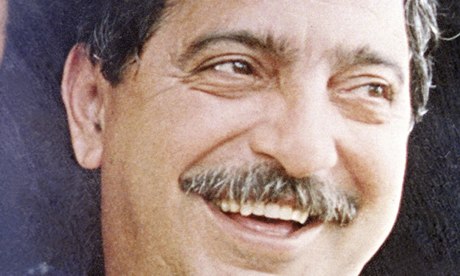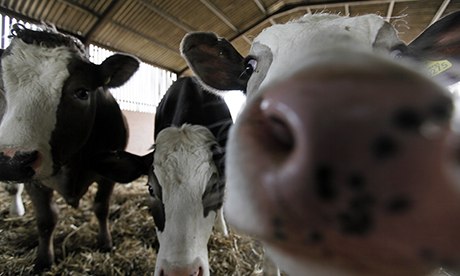When Chico Mendes was gunned down in the Amazon, the two policemen who were supposed to protect him were playing dominoes at his kitchen table. It was 22 December 1988.
The officers had been sent to the union activist's small wooden home in Xapuri after he received death threats from landowners, who were enraged by his campaign to prevent forest clearance. But the police dropped their guard when Mendes stepped out to have a shower in the backyard. A single bullet from a .22 rifle killed him instantly. The assassin, a rancher named Darcy Alves, said "it was like shooting a jaguar".
This weekend,
Brazil will mark the 25th anniversary of that murder, which far from killing off the forest conservation campaign has boosted its profile throughout the country and across the world, influencing a generation of conservationists and policymakers. Mendes is now a symbol of the global environment movement.
The Brazilian government has declared him Patron of the Brazilian Environment. Institutions have been named after him, including the main state agency in charge of conservation – the Instituto Chico Mendes de Conservação da Biodiversidade. After his death, Mendes's home state of Acre in the western Amazon has pioneered the establishment of extractive reserves.
Mendes's story has been the subject of books and films. In recognition of his achievements, there will be memorial ceremonies, documentaries and discussions about his legacy this weekend. Many of his ideas live on through associates, notably
Marina Silva, who became environment minister and put in place Amazon protection systems that are credited with an impressive fall in the rate of
deforestation until recently.
But the celebrations will be tempered by the resurgent influence of the landowners' lobby, a recent
sharp uptick in Amazon clearance and renewed questions about the Brazilian government's willingness to protect forest workers and conserve the biodiverse habitat on which they depend.
Mendes would have recognised the destructive forces at work, though contrary to his reputation as an environmentalist, he was first and foremost a union activist campaigning on behalf of rubber tappers whose way of life was being decimated along with the loss of the Amazon. Mendes had personal experience of the consequences.
Born in 1944, Francisco Alves Mendes Filho – as he was christened – was the son of a soldier in the "Rubber Army", the 50,000 men recruited in 1943 from Brazil's impoverished north-east and shipped to the Amazon to tap rubber for the allied war effort. With Malaya occupied by the Japanese, the US was desperate for rubber, and Brazil promised to revive its once booming rubber industry to meet the need. The tappers were largely abandoned to their own fate, many dying from disease or attacks by wild animals. When the war ended, government promises of compensation and tickets home were forgotten and many, including Mendes's father, never returned.
Growing up in the forest, Chico began tapping as a child. Influenced by priests of the progressive Liberation Theology movement and former members of the Communist party, he helped found the Acre branch of the PT, the Workers' party. As president of the Xapuri tappers' union, he set up a national organisation, bringing the tappers' fight to save the forest to global attention.
American environmentalists took him to Washington to persuade the World Bank, the Inter-American Bank and Congress that cattle projects in the Amazon, which covers an area bigger than western Europe, should not be funded. As an alternative, he proposed the creation of extractive reserves – protected areas that would allow public land to be managed by local communities, with rights to harvest forest products. It marked an important step forward for the conservation community.
In 1987 Mendes won the UN's Global 500 award in recognition of his environmental achievements, although he saw himself primarily as a campaigner for a fairer society. As he said: "At first I thought I was fighting to save rubber trees, then I thought I was fighting to save the
Amazon rainforest. Now I realise I am fighting for humanity."
His opponents were cattle ranchers, who had been moving into the Amazon since the 1970s when they were encouraged by the military who ruled Brazil and financed by official banks. After the dictatorship ended in 1985, these landowners set up the Rural Democratic Union – better known by its Portuguese initials UDR – to thwart the land reforms promised by the government and intimidate unionists and conservation activists. Beatings and killings were common in the remote and largely lawless Amazon region, which is often described as Brazil's wild west.
Mendes was an obvious target. As well as lobbying successfully to end international financing for Amazon clearance, he organised the rubber tappers in non-violent resistance. Men, women and children would form human barricades known as "empates" to prevent the bulldozers from tearing down trees. His success made him many enemies and he knew he was a marked man.
His killer was from a family of cattle ranchers, whose efforts to expand their pastures was held up by the empates. Darcy Alves, 22, and his father Darly were convicted in 1990 and jailed for 19 years. Although they are now free, former associates of Mendes said the assassination backfired. "Those who killed Chico got it wrong. They thought by killing him, the tappers' movement would be demobilised, but they made him immortal. His ideas still have a huge influence," said Gomercindo Rodriquez, who came to Xapuri as a young agronomist in 1986, and later became Mendes's trusted adviser.
Mendes wanted the forest to be used sustainably rather than cut off from economic activity (as some environmentalists wanted) or cut down (as the farmers wanted). He proposed the establishment of extractive reserves for tappers, Brazil nut collectors and others who harvested nature in a balanced way. After his death the first of many such reserves in Brazil, the Chico Mendes Extractive Reserve, was created, covering 1m hectares of forest around Xapuri.
After years of decline, the demand for latex from a local condom factory has boosted the price of rubber, and many tappers, who had turned to raising cattle, have returned to the forest. "This is Chico's legacy," said Gomercindo. "The extractive reserves have meant the preservation of the forest – all around it has been destroyed for cattle pasture. They have become an example, they now exist in other areas of Brazil."
The Chico Mendes Reserve has electricity and schools. Many students have graduated from university. Some tappers now have motorbikes and cars and some have become forest guides. Trees are sustainably harvested, and there is an eco-lodge. Building on this model, 68 extractive reserves have been established in the Brazilian Amazon, covering more than 136,000 sq km.
The Brazilian Space Institute INPE also started satellite monitoring of deforestation the year that Mendes was killed. The timing was a coincidence, but the effectiveness of this program has been heavily influenced by those who were inspired by Mendes. After forest clearance peaked in 2004, the environment minister Marina da Silva, another child of a rubber tapping family and former colleague of Mendes, put in place a more rigorous system of monitoring, penalties and incentives that has resulted in an 80% slowdown in the rate of deforestation.
But this progress is at risk as power in Brazil moves towards big landowners and away from the rural workers, conservationists and indigenous groups that Mendes fought for.
In a sign of the worrying trend, satellite data showed a 28% rise in deforestation this year, breaking a five-year trend of decline.
Ahead of this weekend's anniversary, landowners in Congress vetoed a move to give Mendes's name to the room where the parliamentary agriculture committee meets. But conservation groups have vowed to continue his struggle.
"His legacy is an example that should guide all of us in keeping nature in our minds as a solution and a means to constructing a better world for all", said Claudio Maretti, head of WWF's Amazon Initiative – one of many international organisations that will show their respects for Brazil's Patron of the Environment at this weekend's anniversary.











